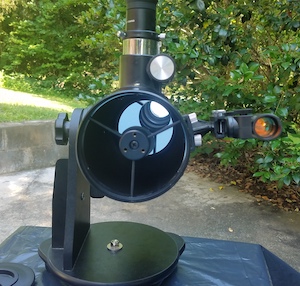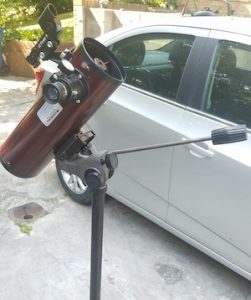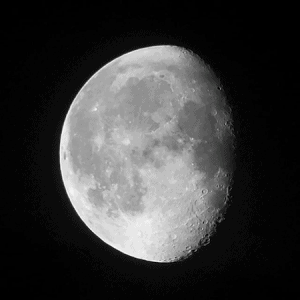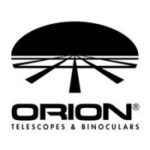Skyscanner’s Newtonian Optical Tube Performance

The SkyScanner’s Newtonian optical tube contains a parabolic primary mirror 100mm (4 inches) in diameter with a focal length of 400mm, yielding a fast focal ratio of f/4. As a result, the telescope is good for wide-field views (showing a large part of the sky at low magnification) without the need for large wide-field eyepieces. While the parabolic mirror is the correct shape for a Newtonian telescope, it is not a diffraction-limited shape like the more expensive Newtonians. This is hard to notice, but it will result in a slightly fuzzier image at very high magnifications. But since the telescope doesn’t come with high-power eyepieces, it won’t be easy to notice this.
The optical tube is given a shiny, pearly red paint job. It looks great on display and is plenty bright when seen outside with a red light.
The tube is outfitted with a Rack-And-Pinion focuser for 1.25” eyepieces, which works fine, and fittings for a finderscope. The dust cap is two-part, so the inner cap can be removed to stop down the aperture for dimmer lunar viewing, which is useful especially during the fuller phases. (This will also reduce the maximum magnification of the telescope, however)
The telescope tube has a vixen-style dovetail mount with three divots for the mounting lock bolt to grab onto for three different possible balance positions. The dovetail would allow the telescope to be mounted on mounts other than the tabletop dob that it comes with, such as an EQ-1 German Equatorial Mount. Two screw holes are also drilled into the dovetail so it can be used with a standard photo tripod.
Like many cheap beginner reflectors, the Orion SkyScanner 100mm does not include provisions for collimating its primary mirror. It holds collimation reasonably well, and I haven’t noticed any problems myself, but a drop or a significant bump might take it out of alignment, and then you’d pretty much have to send it back. Some people have figured out how to make the mirror cell collimatable, but it requires drilling holes, and if I’m not mistaken, the modification means the scope won’t hold collimation as well.
Reviewing Tabletop Dobsonian Mount’s Ability

The Orion SkyScanner includes a tabletop Dobsonian style mount, which uses a lazy susan bottom base for moving side-to-side (through azimuth) and an arm with an altitude bearing for moving up and down (through altitude). The telescope can easily be removed from the mount by unscrewing the locking bolt. In principle, you could mount a different telescope using a vixen dovetail in its place, but that telescope would have to be of a similar size. I believe this mount is identical to the one included with the Orion StarMax 90, which is a Maksutov-Cassegrain telescope with a longer focal length and a shorter optical tube.
The ground board (or table board, more accurately) includes a mounting screw for a standard photo tripod (as pictured), though you’ll need a fairly beefy tripod to make use of it.
The telescope is meant to be placed on a table. If you do so, make sure the table is rock-steady, as any wobbling will be magnified when seen through the telescope. A three-legged table or stool will be more stable, and some people even make their own custom wooden tripods to mount a tabletop telescope. It can also be used on the hood of a car, though as discussed below, I have some reservations about that.
Issues With Focuser Position

The position of the focuser, finderscope, and dovetail is not ideal, because it puts the eyepiece on the top of the telescope. If you point the telescope very near the horizon, the eyepiece is placed far forward and up at the top, meaning you must stand and bend over the telescope to look through it. If you point the telescope up high near the zenith, the eyepiece is pointed horizontally, so you must sit down and look forward.
When the telescope tube is mounted directly to a photo tripod, the eyepiece is at the side in all orientations, which is better, but the tripod should be raised to the eye level of the observer, meaning sharing the telescope between people of very different heights (i.e., a parent showing their child) is uncomfortable.
If the focuser were positioned at 45 degrees from the top of the tube, then it would be easy to use and look through from either a seated position or a standing position when pointed at any altitude. Many tabletop dobs mount the telescope in tube rings so that the telescope can be freely rotated within the tube rings to get whatever eyepiece position is needed at any time, but this is not an option for the SkyScanner.
I’ve seen people modify the tube to move the dovetail to another position, thus providing a better location for the eyepiece.
The result of the focuser position is that it’s not as good a grab-n-go scope as some other tabletop Dobsonians available. I often find myself needing to take out two chairs and a table so I can either put it on the chair for horizon viewing or on the table for high altitude viewing. My FirstScope or a tabletop telescope with tube rings can be placed easily on a car hood.

I’ve found it useful to mount the SkyScanner’s Dobsonian base on the photo tripod, where I can move the height of the tripod up and down fairly easily to accommodate different viewing heights, but that can only be viewed from a standing position.
An astronomical observing chair with an adjustable height might solve these problems, but that’s a bit overkill for a telescope this cheap.
Zhumell makes the Z100, which is essentially the same product but with the eyepiece mounted in a better position.
Some people prefer a top eyepiece position, but for the life of me, I don’t have the faintest clue why.
Reviewing The Provided Accessories
The Orion SkyScanner 100mm comes with two Kellner-type (3-element) eyepieces and an EZ Finder II red dot finder.

The Kellner eyepieces are much better than the trash supplied with most cheap beginner telescopes. They generally show very clear, sharp views, and have acceptable eye relief and field of view. They’re not spectacular, but they’re all you need to get started.
The 20mm eyepiece gives a magnification of 20x, while the 10mm eyepiece gives a magnification of 40x.
The red dot finder is fun and easy to use. You don’t need a magnifying finder with a telescope with such a wide field of view, as spotting objects can easily be done with the 20mm eyepiece. You will have to align the finder on a bright star or planet. Polaris is the easiest to align with since it doesn’t really move in the sky. Once it’s aligned, the red dot finder will project a bright red dot onto the sky (seen through the finder’s window) with no visible parallax (that is, it seems to be as far away as the stars) and will effectively become a bright, large red star in the sky, showing you exactly where your telescope is pointed.
Aftermarket Additions
You’ll probably want to pick up a few extra accessories eventually. A 6mm Kellner eyepiece provides a pretty poor field of view, but can be found very cheaply. A 6mm Gold-Line eyepiece provides the same magnification but with a much wider field of view and a more pleasant viewing experience. They’ll both give 67x magnification.
The minimum power possible with this telescope is 14.4x and can be reached with a 27 or 28mm eyepiece. I recommend a 25-28mm Plossl-type (4-element) eyepiece for the best (reasonably cheap) wide-field views.
You’ll also want to pick up a nice 2.5x or 3x barlow lens for viewing planets and close-up lunar details. You don’t want to cheap out on a barlow—a barlow can potentially last your whole observing career and can be used in any telescope. Budget a minimum of $40 for a decent Barlow lens, and generally don’t go for no-name brands. Barlow lenses effectively increase the focal length of the telescope, and therefore the magnification when used with a given eyepiece. A 2x barlow will overlap magnifications (the 20mm with the 2x barlow will give the same magnification as the 10mm), so get either a 2.5x or a 3x barlow instead, unless you’re already building up a set of eyepieces.
What To See With Orion Skyscanner
One of my favorite objects is the Coat Hanger cluster, but it’s usually a binocular object. The SkyScanner’s fast focal ratio shows plenty of smaller stars in the region and shows the Coat Hanger in splendid, bright detail.
The fast focal ratio also means that the views of faint, fuzzy objects have plenty of surface brightness. My observations of the Dumbbell Nebula (M27) were just as bright with this telescope at 20x power as with my 6” dobsonian at 48x, and about as much detail was visible. The whole of the Sagittarius Star Cloud (M24) fits in the field of view and looks gorgeous.

The telescope is also perfectly capable of viewing the Moon and planets, although its short focal length limits the magnification. You’ll see the rings of Saturn, the moons and bands of Jupiter (and the Great Red Spot when it’s up), the phases of Venus, and possibly even faint dark details on the surface of Mars. Uranus, Neptune, Mercury, and the bright asteroids will be featureless dots. Planetary details will be much easier to spot with a barlow to magnify the image.
The maximum possible magnification with this telescope is 200x, but in practice, you’ll want to stay around 150x or lower. In both cases, you’ll need to combine high power eyepieces with a quality barlow lens.
The Moon will fit fully within the field of view of the telescope with both the 20mm and 10mm eyepieces, but the 10mm will show smaller details. Plenty of crisp and clear detail is visible on the Moon’s terminator. I was able to easily see the rare “Lunar X” feature. I enjoy sketching and drawing objects seen through the eyepiece, and following the Moon’s phases daily and watching the terminator for large and interesting shaded details to draw is a fun way to use this telescope.




Terrific review with many details. Too bad an OEM carrying case accessory isn’t available. It makes a fine traveling scope for any level observer. I do worry about long-term collimation but I like the Orion model over the similar Anime km perhaps because of brand reliability and quality. Thank you for this in-depth review worth reading before purchasing.